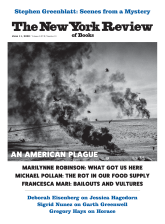In response to:
A Rage for Clarity from the May 14, 2020 issue
To the Editors:
Jed Perl, in his review of the Félix Fénéon show at MoMA [NYR, May 14], speaks of how most historians who have looked at the evidence agree that it’s almost certain that Fénéon planted a bomb at the Restaurant Foyot, one that took out the eye of the writer Laurent Tailhade. Looking at the evidence and the historians’ accounts more closely, that near certainty evaporates.
In the first instance, almost all historians cite the same source, Joan Ungersma Halperin’s brilliant and definitive biography of Fénéon. She, however, bases her account of Fénéon’s guilt not on any solid proofs but on a chain of hearsay (Fénéon supposedly confessed his guilt to the wife of a comrade who told the writer André Salmon who told a friend of his in 1964, who later reported it to Halperin) and the unreliable memoirs of André Salmon, written in 1959, decades after the events. Halperin adds unsourced details of Fénéon’s conduct in the minutes leading up to and immediately following the attack which have no basis in fact, but which lend her account an air of veracity.
There is stronger reason to believe that one of two comrades of Fénéon’s, Armand Matha and Paul Delesalle, the latter of whom disappeared for a time almost immediately after the bombing, might have planted the bomb. None of these men, it must be said, were ever held by the police in connection with the Foyot attentat, nor was Fénéon even questioned at the prefecture.
Another, equally likely possibility, was that the bomb was planted by the police. The device had little power, so did not risk causing death, yet it served the authorities in their war against anarchism, making the anti-anarchist lois scelerates more palatable. The historian Philippe Oriol has presented several other alternatives, including the tsarist Okhrana, again with the aim of darkening the image of the anarchists.
Fénéon was certainly in sympathy with the propagandists of the deed, and there’s nothing in his ideas that would have prevented him from planting the bomb at the restaurant. Nevertheless, the case against Fénéon is far from proven, and certainly is not a matter of near certainty.
Perl in his review also states that Tailhade’s famous quote “What matter the victims, if the gesture is beautiful!” was said to the police after the bombing that cost him his eye. Tailhade made the comment at a banquet, referring to the bomb thrown by Auguste Vaillant onto the floor of the Chamber of Deputies in 1893. The bomb resulted in no deaths but resulted in Vaillant’s execution and further acts of anarchist terror.
Mitchell Abidor
Brooklyn, New York
Jed Perl replies:
Mitchell Abidor’s letter only confirms what I said at the beginning of my review, namely that “Fénéon’s political actions and beliefs, like many of his artistic opinions, aren’t always easy to pin down.” In assessing Fénéon’s involvement in the Restaurant Foyot bombing I am indebted to Joan Ungersma Halperin, whose biography, which Abidor describes as “brilliant and definitive,” leaves a reader in no doubt as to his culpability. Abidor’s disagreement isn’t with me but with Halperin, who describes Fénéon as he lit the fuse and set the bomb on the windowsill of the restaurant. Of course anybody who cares about Fénéon will be interested in the competing narratives that Abidor offers in his letter; the long and the short of it is that he doesn’t regard what he himself describes as Halperin’s “definitive” biography as all that definitive. Perhaps Halperin herself has somewhat modified her view in the more than thirty years since it was first published; in the Museum of Modern Art catalog she refers to Fénéon as “likely the perpetrator” of the bombing. In another essay in the catalog, on Fénéon’s anarchism, Patricia Leighten writes that “it is believed that Fénéon set the next bomb [at the Restaurant Foyot] himself.” My “almost certain” was meant to acknowledge these issues. None of this has anything to do with my central argument, namely that Fénéon’s attitudes toward art and politics should not and cannot, pace the curators of the exhibition at the Museum of Modern Art, be viewed as “two sides of the same coin.”



